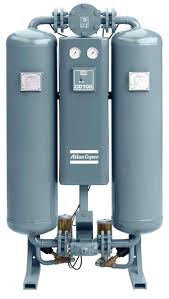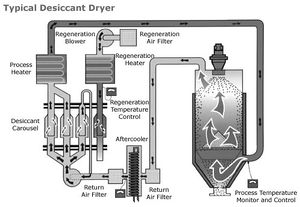Difference between revisions of "Desiccant Dryers"
| (15 intermediate revisions by 2 users not shown) | |||
| Line 1: | Line 1: | ||
[[Category:Drying]]{{Knoppen}} | [[Category:Drying]]{{Knoppen}} | ||
[[File:Desiccant_Dryers.jpg|thumb|right|Desiccant Dryers]] | |||
[[File:Desiccant_Dryer_Principle.jpg|thumb|right|Desiccant Dryer Principle]] | |||
The '''Desiccant Dryers''' are used for drying air in [[Storage Tanks]] or pneumatic systems and are beneficial in the drying of hygroscopic (water-absorbing) resins. These [[Dryers]] remove water from the air by passing it through a desiccant that absorbs moisture. The term "desiccant dryer" refers to a broad class of [[dryers]]. Other terms commonly used are [[Regenerative Desiccant Dryers]] and [[Twin Tower Dryers]], and to a lesser extent [[Absorption Dryers]]. | |||
The compressed air is passed through a [[Pressure Vessels|pressure vessel]] filled with an absorbent media such as activated alumina, silica gel, molecular sieve or other desiccant material. The desiccant can bring the dew point of the water vapor in the air down to −40 °C (−40 °F) or below. This means that the air will not condense (deposition) water until it is cooled to −40 °C (−40 °F). In practice, two cylinders with desiccant are used; one is drying the air, while the other vessel is being regenerated. The switching of the vessels and the regeneration sequence is typically done automatically via solenoid operated [[valves]] The regeneration of the desiccant vessel can be during three different methods. | |||
The '''Desiccant Dryers''' are used for drying air in | |||
[[Heatless Dryers]], which uses part of the dry compressed air coming from the other vessel to dry the desiccant in the vessel being regenerated at lower pressure. [[Heated Dryers]], which uses a hot air blower, so there is no loss of compressed air. Heat of compression, which can only be used with an oil free compressor. | |||
==Features== | ==Features== | ||
Desiccant dryers consist mainly of two cylinders containing desiccant, connected by a valve system.==Operation==When the desiccant in the first cylinder is saturated, the air flow can be switched to the cylinder containing the dried desiccant. | Desiccant dryers consist mainly of two cylinders containing desiccant, connected by a valve system. | ||
==Operation== | |||
When the desiccant in the first cylinder is saturated, the air flow can be switched to the cylinder containing the dried desiccant. | |||
==Dessicant Types== | ==Dessicant Types== | ||
Common desiccants are silica gel (an oxide of silica), alumina (aluminum oxide) and calcium sulfate (the anhydrous form of gypsum). | Common desiccants are silica gel (an oxide of silica), alumina (aluminum oxide) and calcium sulfate (the anhydrous form of gypsum). | ||
==Types of Dryers== | ==Types of Dryers== | ||
While manual desiccant dryers exist, many dryers are | While manual desiccant dryers exist, many dryers are [[Regenerative Desiccant Dryers]]. | ||
==Most Expensive== | ==Most Expensive== | ||
Heatless regenerative desiccant dryers run a portion of dried compressed air through the previously utilized cylinder to extract moisture from its desiccant. | Heatless regenerative desiccant dryers run a portion of dried compressed air through the previously utilized cylinder to extract moisture from its desiccant. | ||
==Least Expensive== | ==Least Expensive== | ||
Heated purge regenerative desiccant air dryers use less air than the heatless variety in addition to heat, which helps the air carry away more water as it passes through the saturated desiccant.==Best Compromise==Heated blower purge regenerative desiccant air dryers use air from outside the dryer that is heated and sent through the water-saturated desiccant for drying. | Heated purge regenerative desiccant air dryers use less air than the heatless variety in addition to heat, which helps the air carry away more water as it passes through the saturated desiccant. | ||
==Best Compromise== | |||
Heated blower purge regenerative desiccant air dryers use air from outside the dryer that is heated and sent through the water-saturated desiccant for drying. | |||
==Classification== | ==Classification== | ||
There are different types of regenerative desiccant compressed air dryers. These are: | There are different types of regenerative desiccant compressed air dryers. These are: | ||
* Small Heatless Desiccant Air Dryers | * Small Heatless Desiccant Air Dryers | ||
* Large Heatless Desiccant Air Dryers | * Large Heatless Desiccant Air Dryers | ||
* Compact Heatless Desiccant Air Dryers | * Compact Heatless Desiccant Air Dryers | ||
* Mini Heatless Desiccant Air Dryers | * Mini Heatless Desiccant Air Dryers | ||
== | ==Video== | ||
<youtube>h3SdBj8tE7o</youtube> | |||
Latest revision as of 06:00, 17 February 2013
The Desiccant Dryers are used for drying air in Storage Tanks or pneumatic systems and are beneficial in the drying of hygroscopic (water-absorbing) resins. These Dryers remove water from the air by passing it through a desiccant that absorbs moisture. The term "desiccant dryer" refers to a broad class of dryers. Other terms commonly used are Regenerative Desiccant Dryers and Twin Tower Dryers, and to a lesser extent Absorption Dryers.
The compressed air is passed through a pressure vessel filled with an absorbent media such as activated alumina, silica gel, molecular sieve or other desiccant material. The desiccant can bring the dew point of the water vapor in the air down to −40 °C (−40 °F) or below. This means that the air will not condense (deposition) water until it is cooled to −40 °C (−40 °F). In practice, two cylinders with desiccant are used; one is drying the air, while the other vessel is being regenerated. The switching of the vessels and the regeneration sequence is typically done automatically via solenoid operated valves The regeneration of the desiccant vessel can be during three different methods.
Heatless Dryers, which uses part of the dry compressed air coming from the other vessel to dry the desiccant in the vessel being regenerated at lower pressure. Heated Dryers, which uses a hot air blower, so there is no loss of compressed air. Heat of compression, which can only be used with an oil free compressor.
Features
Desiccant dryers consist mainly of two cylinders containing desiccant, connected by a valve system.
Operation
When the desiccant in the first cylinder is saturated, the air flow can be switched to the cylinder containing the dried desiccant.
Dessicant Types
Common desiccants are silica gel (an oxide of silica), alumina (aluminum oxide) and calcium sulfate (the anhydrous form of gypsum).
Types of Dryers
While manual desiccant dryers exist, many dryers are Regenerative Desiccant Dryers.
Most Expensive
Heatless regenerative desiccant dryers run a portion of dried compressed air through the previously utilized cylinder to extract moisture from its desiccant.
Least Expensive
Heated purge regenerative desiccant air dryers use less air than the heatless variety in addition to heat, which helps the air carry away more water as it passes through the saturated desiccant.
Best Compromise
Heated blower purge regenerative desiccant air dryers use air from outside the dryer that is heated and sent through the water-saturated desiccant for drying.
Classification
There are different types of regenerative desiccant compressed air dryers. These are:
- Small Heatless Desiccant Air Dryers
- Large Heatless Desiccant Air Dryers
- Compact Heatless Desiccant Air Dryers
- Mini Heatless Desiccant Air Dryers
Video

